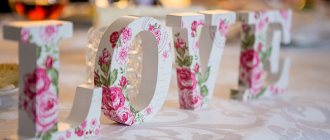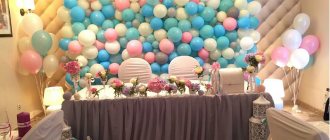The wedding custom of throwing the bride's bouquet behind her back, where her unmarried bridesmaids catch it, came to us from Europe. In the Middle Ages, the faith of ladies in the magic of this ritual was so strong that the most desperate of them actively tried to tear off scraps of fabric from the dress of the girl who was walking down the aisle.
Of course, the heroes of the occasion did not want to give up their magnificent outfit to be torn to pieces. In this regard, a tradition arose of attaching flowers to the bride’s dress, which guests carefully removed “for good luck.” However, pinning the plants was not a very convenient solution. This is why you need a duplicate bouquet for a wedding these days.
How to use
Some products, due to their awkward shape or too large size, can play a cruel joke on the bride during the throwing ceremony. Intricate arrangements with cascading flowers and greenery are very difficult to throw into the air. Owners of large bridal bouquets do not have a question about why they would need a duplicate bouquet for their wedding.
By replacing them with less traumatic analogues, you will protect your guests and insure against accidental damage to objects in the environment. In addition, many girls feel sorry to part with such a memorable thing. Therefore, the girl wonders whether a duplicate bouquet is needed for the wedding. Previously, it was rarely used, but now its popularity has increased dramatically.
Florists explain why you need a stand-in bouquet at a wedding. Sometimes a wedding lasts longer than one day. As a result of numerous changes in location, fragile plants may lose their attractiveness. Sometimes newlyweds hold a wedding in the winter season, when even the most persistent buds can fade due to sudden temperature changes. Read more about winter wedding bouquets.
An understudy for the bride's wedding bouquet ensures that the flowers look fresh throughout the entire celebration. In addition, it can be a wonderful addition to the second wedding outfit, since dressing up the bride is a new fashion trend. During the celebration, these flowers can be given “for safekeeping” to the witness or some little girl present among the guests.
When choosing a replacement flower arrangement, you can choose one of three options.
- An identical copy of the main bouquet. An ideal choice if the wedding takes place in winter or lasts two days. As a result, in all wedding photographs the hero of the occasion will be holding a chic composition of fresh plants in her hands.
- Bridal bouquet in miniature. It consists of the same colors as the main one, but is smaller in size and relatively light in weight, which makes it more convenient during the throwing ceremony.
- A composition of artificial flowers, as close as possible to the original in color and composition. It can be left as a keepsake, remembering with love and nostalgia one of the most significant events in life.
You can buy a duplicate bridal bouquet, but some people decide to make it themselves.
Why does a bride need a second bouquet at a wedding?
And if you imagine that the bride is a pedantic girl, and dried flowers that collect mountains of dust are not an option for her, then the need for an additional bouquet completely disappears? Not at all!
At the moment of throwing the bouquet, the second copy will give a significant head start to the gorgeous flowers in the hands of the hero of the occasion. Why is it easier and preferable for the bride to leave him?
- A wedding bouquet looks gorgeous, but is often dangerous. Unmarried guests are unlikely to appreciate a heavy portaquet or metal decorative ornaments that can fly right into their head.
- Pollen from fresh flowers leaves stubborn stains on clothes. The joy from the caught bouquet on the bridesmaid’s face will immediately fade with the thought that this chic black dress was worn for the first and last time.
- The composition in the hands of the newlywed can be extremely complex (basket, fan, cascade, etc.), such design features simply will not allow it to be abandoned. And if the elements of the bouquet are barely fixed to each other, then during the flight they will easily scatter around - you will have to “admire” scraps of flowers on the floor, tables with food and even in the hair of guests.
In addition, a duplicate bouquet will come in handy if:
- The wedding ceremony is held in winter, so there are doubts that the bride’s flowers will retain their attractive appearance under constant temperature changes.
- The holiday is magnificent and lasts several days, as, for example, in the Caucasus. There is hardly a flower arrangement that can withstand such active festivities. But you really want the bride’s image to remain perfect on both the second and third days of the wedding.
- The main bouquet is made up of extremely delicate, “capricious” representatives of the flora, susceptible to the slightest environmental changes.
Useful video: master class
It’s easy to make a duplicate bouquet for a wedding with your own hands. One of the most common and favorite materials for a double bouquet is satin ribbon. It looks chic and goes well with a full skirt with a corset. The bright colors of the material are in harmony with the white dress. Making a duplicate bouquet for the bride with your own hands - master class on video:
To create a rose from satin ribbon you will need:
- Tape 12-15 cm wide;
- Thread matching the color of the ribbon with a needle;
- Toothpick;
- Glue;
- Green satin ribbon.
Instructions for creation.
- On one side along the length of the tape, collect the material using a needle and thread.
- Secure the resulting assembly with glue on a toothpick.
- Wrap the assembled part around the toothpick and straighten the loose part. Secure the result with glue.
- Wrap green tape around the toothpick and seal it.
- The rose is ready! Make the required number of flowers of each color, and create a bouquet further.
You can make chrysanthemums, tulips and other flowers in approximately the same way. Beads and rhinestones are added to the middle of the flowers. This technique is called kanzashi. The master class showed how to arrange duplicate bouquets for a wedding, and some simple tips will help you make the design.
We create a cascading bouquet-understudy from artificial flowers
In this small master class, I decided to show you how to make a cascading double bouquet using the taping technique. I don’t know if anyone else makes doubles in this way, but I like this technique because it allows you to create absolutely any shape of a bouquet, be it an ordinary hemisphere or a “waterfall” all the way to the floor.
So let's get started!
Necessary materials:
- small heads of roses (about 40 of them were needed for this work);
- rose leaves 10 pieces;
- a pair of white carnation bushes;
- several sprigs of greenery with miniature leaves;
- floral wire 0.7 mm thick;
- tape;
- hot-melt gun and hot-melt adhesive;
- scissors;
- wire cutters;
- satin ribbons 4 cm and 2.5 cm wide (2 meters each);
- lace 50 cm;
- beads (15 pieces);
- decorative button.
Let's get to work. We cut the carnation branches from the bushes so that we have “legs” left from them. In order to collect rose heads into a bouquet, you must first form stems for them. Here we need the wire that is left over from the cloves.
Cut it into pieces, 4-5 centimeters each. We will need as many such pieces as the number of rose heads we will use.
Next we need to put the rose heads on these pieces of wire. To do this, we apply a drop of glue to the tip of the wire and put on our roses. It looks like this:
We continue to form the stems. We take the floral wire and wrap it around our legs so that the ends of the wire go down, extending the existing legs. We do the same with the rest of the flowers and greenery.
Now we need to tape the wire. To do this, take a tape and from top to bottom, stretching it a little, wrap the ends of our wire tightly and neatly with it. Now the legs are ready. At first glance, to someone who has not yet worked in the taping technique, this process may seem long, but when “the hand is already full,” it is done quickly.
Now you can start assembling. We take one flower at a time and begin to put them together, forming a “cap” of the bouquet.
Here it is better to do this: fold several stems and secure them with tape. Then they added more and fixed it again.
So we continue to add flower to flower, alternating red with white and adding small greens, trying to give the bouquet the shape of a hemisphere.
Here we could stop and start decorating the handle of the bouquet, but since it should be cascading, we will form its falling part. To do this, we take one rose in our hand, then, a little lower (lower to the height of its head), we put two other roses. There are three more things underneath them. In between, don’t forget to add cloves and herbs. And so on for several rows, depending on how long the cascade we want to make. It is shaped like a Christmas tree.
Next you need to connect the top and bottom parts of the bouquet. To do this, we bend the lower part and apply it to the upper one so that together they form a single whole. Secure with tape.
Now we begin to decorate the stem of the bouquet. First, we cover the edges of the leg with rose leaves and secure it again with tape.
We cut a satin ribbon 4 cm wide into 8 pieces of 10-12 cm each. We fold each piece in half, bend it as shown in the photo and fix it with glue.
We glue the stem of the bouquet with these blanks around the perimeter.
We determine how long we want to leave the stem and cut off the excess stems with pliers. And again we fix them with tape.
Next, we decorate the leg along the entire length with a 2.5 cm wide ribbon.
We glue beads into the center of some roses. We tie or glue a lace ribbon onto the leg, at the top and decorate with a decorative button.
Well, that's all, our bouquet is ready! If you liked my master class, or you found something useful in it, please click “like”, as it is participating in the competition.
Assembly
After you have made the flowers, you need to create a beautiful and harmonious composition.
To do this you will need:
- half a foam ball with a diameter of 11 cm;
- cardboard tube 17 cm long;
- satin ribbon of a suitable color to match the flowers;
- scissors;
- glue gun;
- ready-made flowers;
- additional decorations;
- thread and needle to match the color of the ribbons.
There is an interesting option, how you can make a duplicate bouquet for a wedding from satin ribbons. It has a number of advantages, for example, it does not wither and can be stored for a long time, like a memory. But, on the other hand, not everyone will decide to go with him to the registry office and do a photo shoot. Let's look at how to make a double bridal bouquet.
- In the center of the foam ball, make a depression the diameter of a tube.
- Cover the tube with tape around the circle and at the base.
- Then glue it to half the ball.
- Distribute the finished flowers around the perimeter, gluing them.
- Also add decorations as you wish.
- Fold small pieces of ribbon in half, then sew them together.
- Create a circular composition from them, securing them with thread.
- Place it on the tube and secure it with glue to the ball.
- Roll the ribbon into a bow.
- Sew it together with a needle and thread.
- Add smaller ribbon and beads for decoration.
- Glue the bow at the bottom under the base of the composition.
For such a bouquet, flowers made from polymer clay and foamiran are best suited. A master class on making a double bridal bouquet gives basic ideas, and the bride herself can come up with the details.
Which bouquet to choose
Fabrics, ribbons, paper and decor are suitable for making a duplicate bouquet.
A duplicate bouquet does not have to be a complete copy of the original. Typically much lighter and smaller in size, it can replicate the color scheme or shape of the original, or imitate a complete floral arrangement. Sometimes such a bouquet is made from natural flowers, in which case each flower is carefully secured so that it does not scatter in the air. But the most popular options are made from artificial flowers, fabric, satin ribbons or paper.
Tips for creating
The most interesting stage is decorating the bouquet. There are no restrictions here - the result depends solely on your taste preferences.
You can make improvised petals from wide green ribbons by bending them in half and attaching them to the handle. Rhinestones and beads look incredibly beautiful surrounded by satin flowers. If you have some imagination, you can wrap the base of the bouquet with lace, imitating the floral packaging that is familiar to us.
Interesting! The bride's bouquet can be thrown in an original way. How exactly - read in this article of ours.
To ensure that your hand-made bridal bouquet duplicate stays in its original state longer, treat it with a special product that preserves the aroma.
An original solution would be lyophilization - dry freezing of flowers that will make up a stand-in bouquet for a wedding, also known as sublimation. Afterwards, you can place the bouquet in a beautiful glass vase so that it continues to delight the couple. At a wedding ceremony, frozen flowers can add some zest if you make them the center of the serving composition during the feast.
Fragrant beauty
Retail chains offer amazing sets of your favorite natural flowers. However, the temptation to create beauty yourself remains. For the bride's bouquet, orchids, chrysanthemums, roses, and eustomas are used. For greenery - eucalyptus, salal, fern, asparagus. You will need wire, floral ribbons, and decor.
Before assembly, certain manipulations are carried out with the plants. Flowers that are placed on the outer edge need a wire splint that regulates the position of the buds. The width of the wire depends on the thickness of the trunk. Plant preparation:
- Orchids. The flowers are removed from the stem, leaving a stem of no more than 7 cm. Moisten half a cotton pad with water. Wrap the cut in it. A wire 40 cm long and 1.2 mm in cross section is bent in half. Place it on the stem of the plant with the fold upward and wrap it with an adhesive floral strip. Then wrap it with tape.
- Roses. For thin stems, use wire 1 mm in diameter. For large ones, a thickness of 1.2 mm is suitable. A piece of 35-40 cm is folded in half and connected to the stem of the bud with green or brown tape, starting from the base of the flower. The excess wire is cut off.
- Chrysanthemums, eustomas. Manipulate with a cotton ball, like an orchid. The wire is attached to the stems in the same way.
Assembly Rules
Determine the shape - plate, oval, sphere, fan. The highest point of the bouquet is in the center. Each bud is separated from its neighbors by a sprig of greenery. Collect from the middle, adding flowers in a circle. The buds turn outward. Every 5-10 plants are wrapped with florist's tape.
At the final stage, greenery is placed in a circle, hiding unsightly details. The composition is tied with polybast tape. Level the bottom and trim.
The stems are connected and wrapped with tape. The leg is decorated with satin, beads, lace - there are many variations.
Creating a unique bouquet is a complex matter; work begins long before the event . However, the result - an exclusive accessory - is worth the effort and worry.
Summary
Don't be afraid to show your imagination. Why not follow the example of brides who attach miniature photographs of people who, for one reason or another, could not attend the wedding to the handle of the bouquet? Or do they plant an artificial butterfly on one of the flowers to create a light and airy effect? Experiment to make the memory of your wedding last for years to come!
admin 115
Previous article
A bad omen about someone else’s outfit: what will happen if you try on a friend’s wedding dress
Next article











